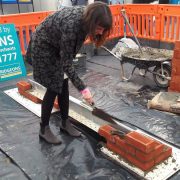We need bricklayers – not robots
A shortage of bricklayers and scaffolders is holding back Britain’s construction. Here Pippa Jacob, who had a go at bricklaying at the Suffolk Skills Show last week, takes a closer look at the problem.
If my attempt at bricklaying proved anything to me it was that things are never as easy as they look. This is a highly-skilled trade, requiring dexterity, speed and precision. And this, I realised, is why the need to recruit in this area is not just about availability. It is about talent too.
What’s the situation?
Ask anyone trying to get on the housing ladder and they’ll tell you Britain is in a housing crisis – for many, home ownership has become an unaffordable dream. But as well as problems of price, there is a major issue with supply and demand. The truth is not enough houses are currently being built.
This is the result of an extreme skills shortage. The building industry has been aware of the problem since the end of the financial crisis – which caused 300,000 people to leave the industry. Kick-started back to growth by the Government’s Help to Buy programme, the sector found it no longer had enough people to do the work – and it’s been struggling ever since.
Despite a recruitment drive, bricklayers in particular, remain in high demand.
Beware of the robots
In America they are trying to solve this problem with robotics. SAM100 builds walls six times faster than a human bricklayer and can lay 3,000 bricks per day using its combination of a conveyor belt, robotic arm, and concrete pump. By comparison, a human builder will average around 500 bricks per day.
My thoughts are that its great the construction industry is adopting new technology as long as it isn’t at the risk of losing skilled craftsmen. And SAM’s inventors Construction Robotics claim it is not trying to put human laborers out of business.
“We don’t see construction sites being fully automated for decades, if not centuries,” a spokesman said. “This is about collaboration between human workers and machines. What SAM does is to pick up the bricks, put mortar on them, and puts it on the wall. It still requires a mason to work alongside it. SAM’s just there to do the heavy lifting.”
Filling the gap
If you don’t have a spare $500,000 to spend, it’s back to the drawing board with recruitment to fill our skills gap here in the UK.
Building a wall in your back garden might seem easy, but doing it to a standard required in the industry and at speed takes time to learn. Trust me, my very brief attempt at the Suffolk Skills Show proved this.
But while we are short of skilled workers, wages are being pushed up, impacting the profitability of companies, and most importantly, limiting the number of homes that can be built. And things could get even worse should post-Brexit immigration controls limit the number of workers from overseas — a key recruiting ground for the construction sector — coming to the UK.
There is no simple solution to this problem. But we need to continue to bring new blood into the sector and champion the extensive and exciting range of career choices in construction and building design.






Leave a Reply
Want to join the discussion?Feel free to contribute!